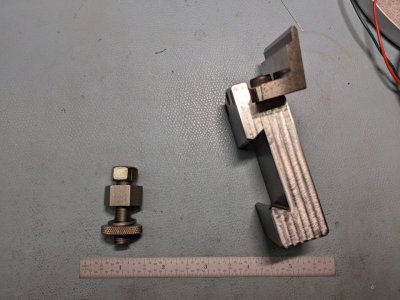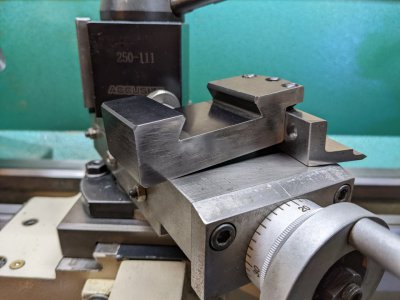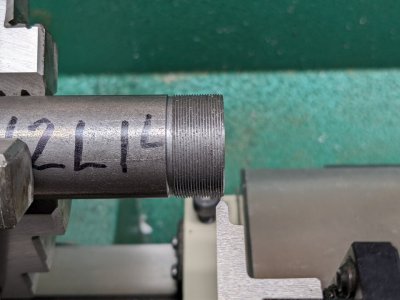- Joined
- Dec 18, 2019
- Messages
- 6,464
A while back I bought an Aloris AXA-8 HSS threading holder and blade. Due to a misunderstanding on my part, I found that the holder and blade could not be set to centerline on my lathe. The height from the top of the compound to the centerline was 0.947" and the height from the bottom of the tool holder to the top of the cutter was 0.994". My choices were either to grind the HSS cutter, or mill off the bottom of the tool holder. Decided that milling the bottom was the easier of the two choices.
Milled off the bottom of the holder using a 0.020 radius carbide end mill. Wasn't the smoothest of finishes, but it did cut through the hardened steel holder. I took off around 0.050". I then used a series of diamond honing stones to further polish the bottom surface. It's not quite mirror flat, but it's good enough. Toolholder was sitting on my desk awhile. Today I thought I'd try it out.


Standing in front of my used Grizzly G0752Z, I tried to interpret the threading chart. Thought I'd set up for a very fine pitch, so my first threading on this lathe would be less exciting. After a bit, it started to sink in. Eventually I made a simple, condensed spreadsheet for some common threads that I might make. Since I need to make a screw that is 1/4-40, for a project, thought I'd set up the gears for that pitch. After some awkward moments, including dumping the E clip on the ground, finally got the lathe set up for 40 pitch. For those that might still be following along the settings are: C, I, 36, 40. Have to say, I see why people desire real quick change gear boxes. I'm already considering Clough 42's ELS. Was even more awkward than changing gears in a mini-lathe. I know I'll get used to it, but it's definitely messy and little parts do go flying. It reminds me to buy a couple spare clips and things from Grizzly.
I set the center height of the AXA-8 by using a 1" rod in the chuck and measuring down 1/2 the diameter. I had previously used a micrometer on the rod. Using a dial caliper set it to 1/2 diameter, then adjusted the cutter until it just touched. I have a few thousandths of daylight between the top of the compound and the bottom of the AXA-8. Being lazy, I decided to thread the 1" 12L14 rod at 40 pitch. Did a scratch pass and amazingly enough, it was 40 pitch! Didn't think I would get it the first time.

Threads cut very nicely. Glad I chose a 40 pitch thread for the first threads as it let me get used to the timing for setting the half nuts. An 8 pitch thread would be 5 times faster. Didn't bother measuring the threads with wires as this one was just for fun. I have to calculate what would the pitch diameter be? 1"-40 is not a UNS thread.
So at least for me, a couple of minor victories. Got the AXA-8 set up, and my first single point threads on this lathe. Wish I could clean the 40 TPI threads out. The threads just cut the paper towels and shredded them. Also did a number on the pipe cleaner I tried.
Milled off the bottom of the holder using a 0.020 radius carbide end mill. Wasn't the smoothest of finishes, but it did cut through the hardened steel holder. I took off around 0.050". I then used a series of diamond honing stones to further polish the bottom surface. It's not quite mirror flat, but it's good enough. Toolholder was sitting on my desk awhile. Today I thought I'd try it out.


Standing in front of my used Grizzly G0752Z, I tried to interpret the threading chart. Thought I'd set up for a very fine pitch, so my first threading on this lathe would be less exciting. After a bit, it started to sink in. Eventually I made a simple, condensed spreadsheet for some common threads that I might make. Since I need to make a screw that is 1/4-40, for a project, thought I'd set up the gears for that pitch. After some awkward moments, including dumping the E clip on the ground, finally got the lathe set up for 40 pitch. For those that might still be following along the settings are: C, I, 36, 40. Have to say, I see why people desire real quick change gear boxes. I'm already considering Clough 42's ELS. Was even more awkward than changing gears in a mini-lathe. I know I'll get used to it, but it's definitely messy and little parts do go flying. It reminds me to buy a couple spare clips and things from Grizzly.
I set the center height of the AXA-8 by using a 1" rod in the chuck and measuring down 1/2 the diameter. I had previously used a micrometer on the rod. Using a dial caliper set it to 1/2 diameter, then adjusted the cutter until it just touched. I have a few thousandths of daylight between the top of the compound and the bottom of the AXA-8. Being lazy, I decided to thread the 1" 12L14 rod at 40 pitch. Did a scratch pass and amazingly enough, it was 40 pitch! Didn't think I would get it the first time.

Threads cut very nicely. Glad I chose a 40 pitch thread for the first threads as it let me get used to the timing for setting the half nuts. An 8 pitch thread would be 5 times faster. Didn't bother measuring the threads with wires as this one was just for fun. I have to calculate what would the pitch diameter be? 1"-40 is not a UNS thread.
So at least for me, a couple of minor victories. Got the AXA-8 set up, and my first single point threads on this lathe. Wish I could clean the 40 TPI threads out. The threads just cut the paper towels and shredded them. Also did a number on the pipe cleaner I tried.


